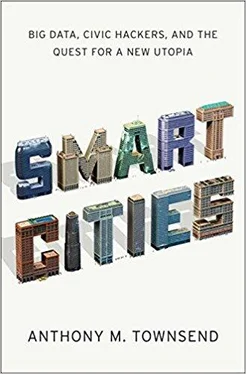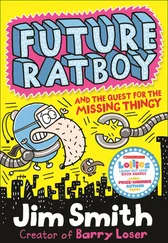What if, instead, we just helped each other find things? Instead of creating an infrastructure for machine surveillance to find our lost stuff, we could build one for social cooperation that provides the same capability—but faster, cheaper, and with positive social side effects. This is the idea behind Phoundlt, an app that bills itself as “lost and found, redesigned for the connected city.” Using the Foursquare API, Phoundlt takes reports of lost items, and alerts users when they check in somewhere to be on the lookout for them. When something is found, there are tools to arrange a safe return. As Elan Miller, the projects founder explains, the goal is to “make it easy for the community to act on their inherent goodwill and inspire others to do the same.”64 Phoundit demands a lot from us, but unlike the automated system, it dangles the enticing prospect of meaningful human contact. It appeals to basic human altruism, but also our inherent desire to be social and seek out new relationships. There is a sustainability angle too: instead of consuming more by simply replacing lost objects, Phoundlt s users extend their working life. There’s also no need to manufacture billions of RFID tags and a global infrastructure to track them.
The lesson is: don’t lose sight of the slow data in the torrent of big data. The real opportunity to design killer apps for smart cities lies in those niches where a couple of heavily value-laded bits can be created—just as the Foursquare check-in and the Facebook “like” have. Slow data’s power is its ability to induce behavior change—as we saw with the Botanicalls project that matched a tweeting houseplant with a caregiving network of grad students. And slow data can complement big data—whenever efficiency is warranted, it should be paired with mechanisms that deliver those behavior-changing bits into the foreground of our social lives, where we can think about the trade-offs. Big data may streamline our wasteful ways, but it will take slow data to change them. Big data may make us lean and mean. Slow data will speak to our souls.
I’m often asked, “What’s the smartest city?”
My answer is always the same. “The one you live in.”
It sounds glib, but I’m serious. The idea of a single, utopian design for the smart city has kept us from the hard work of building a rich and varied collection of ones that we can actually live with. Since 2008, the vision of our urban future has come to be dominated by companies that would repeat the cookie-cutter city designs of the twentieth century on a planetary scale, powered by the technology of global enterprise. Our mayors are putting their own spin on these designs, but they can’t solve all of our problems.
The answer lies at the grass roots. I see it blossoming everywhere as we take these tools out into the streets and use them to reimagine and remake our world. We thought the Internet was about transcending the globe, and then it took a hyperlocal turn and became about swapping reviews of restaurants and getting free coupons for the local shop. We thought it would isolate social groups, and then it connected us all into one big network. We thought it was about staying home and looking at physics papers or LOLcats, and then in just a few years it powered over a million meatspace meetups.
Smart-city hackers can’t do it alone. While we can show our business leaders and politicians how to build a more just, social, and sustainable future, we need their help to reach critical mass. Like Patrick Geddes, I believe that it will take a social movement that enlists science, the humanities, and us all to address the challenges we face building a planet of cities that can survive. Whether we call it an urban operating system or the industrial Internet, something really big is booting up in the half- million-plus civic laboratories on planet Earth.
Are you going to help build it?
You have everything you need.
he technology of the smart city is well hidden. It lives underground and inside walls, hides in our pockets, and rides on the airwaves around us. But when a jackhammer- wielding crew peels back the hard asphalt of a city street, the guts of the metropolis are revealed. Among sewer pipes and gas lines laid many years ago, a digital nervous system now resides.
Recently, one of these infrastructural incisions opened up not far from where I first discovered Dennis Crowley’s Dodgeball app a decade ago. Back then, smartphones were still years away. But the area around Manhattan’s Astor Place was now a hub for the business of big data—much of it generated by apps like Facebook’s—running on millions of those little supercomputers in our pockets. The social-networking giant had recently relocated its New York staff of more than three hundred to the old Wanamaker’s Department Store building on the west side of the busy square.
But Facebook wasn’t to blame for the new subterranean action. An ever bigger data hog was in the neighborhood. Months earlier, IBM had announced that it would locate its new Watson Group in One Astor Plaza, just across the street from Facebook. Watson was the most ambitious effort in history to turn artificial intelligence into big bucks, a collection of algorithms in the cloud designed to find meaning in big data. Watson promised to bring superintelligence to all manner of human decision making, from the analysis of CAT scans to the deployment of police forces.
IBM’s $1 billion investment would put two thousand geeks in Crowley’s old stomping grounds. The sleek, jet-black tower loomed ominously over the throngs of students and skate punks that clustered around its base. Amid the city buses and food trucks that jostled for curb space stood a gray van, parked aside a freshly dug trench in the street. “Empire City Subway” read the lettering on its side. But ECS (as the company is known) doesn’t build subway tunnels for trains. It builds tubes for telecommunications.
The smart city had never seemed more concrete. Watson needed data, and lots of it, to feed its pattern-matching prowess. The digital plumbers from ECS were tearing the street apart to make way for the fiber-optic cables that would carry bits to IBM’s machine minds.
Smart Cities was an attempt to chalk out a big, forward-looking picture of what digital technology means for cities.
But one of the challenges of forecasting is that while you may get the general direction of change right, nailing the magnitude can be tricky. If you try to stay plausible by today’s assumptions, you run the risk of underestimating the potential for sudden, rapid change in the future. With smart cities, trends that only recently appeared small on the horizon now loom larger and larger. Everything seems to be speeding up, getting bigger, or getting worse than was expected.
The title of Chapter 1 was chosen deliberately to shock and awe. Borrowing a figure from a key market forecast, “The $100 Billion Jackpot” was the pie big technology corporations hoped to carve up among themselves by 2020. Yet just a few weeks after this book’s first publication, and barely three years after that earlier estimate, the UK government announced its own prediction—over $650 billion annually by 2020. Tabulated by analysts at engineering giant Arup, this new calculation assumed a much broader definition of the industry. But it corroborated other intelligence. The market was vaster than anyone had dared imagine.
Yet even as the financial outlook for smart cities went supernova, fears that the biggest smart-city outfitters would dominate the action turned out to be overblown. In this case, the trend line fell far short of what many expected. None of the big technology and engineering companies that sought early on to corner the smart cities market—IBM, Cisco, and Siemens—have met their revenue targets. A key goal of Smart Cities was to get people thinking about the risks of letting big tech companies design future cities. It now seems these companies overestimated their ability to take the high ground.
Читать дальше












